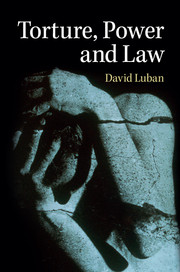Book contents
- Frontmatter
- Dedication
- Contents
- Preface
- Acknowledgments
- I Downgrading rights and expanding power during post-9/11 panic
- II The ticking bomb as moral fantasy and moral fraud
- 3 Liberalism, torture, and the ticking bomb
- 4 Unthinking the ticking bomb
- III The evils of torture
- IV Complicity in torture
- Main index
- Index of legal authorities
- References
3 - Liberalism, torture, and the ticking bomb
Published online by Cambridge University Press: 05 September 2014
- Frontmatter
- Dedication
- Contents
- Preface
- Acknowledgments
- I Downgrading rights and expanding power during post-9/11 panic
- II The ticking bomb as moral fantasy and moral fraud
- 3 Liberalism, torture, and the ticking bomb
- 4 Unthinking the ticking bomb
- III The evils of torture
- IV Complicity in torture
- Main index
- Index of legal authorities
- References
Summary
Preface
This chapter was published concurrently in its present form and in a more extended version that appeared in Karen Greenberg’s collection The Torture Debate in America (Cambridge University Press, 2005). The latter version included a longer and fuller analysis of the torture memos; I have used the shorter version here because other chapters of this book go into the torture memos in greater detail. The chapter received wide circulation: in March 2006 it was excerpted in Harper’s Magazine and published in translation in the German cultural magazine Die Zeit Kursbuch. Together with the following two chapters, it represents the philosophical core of this book’s analysis of torture and its critique of discussing torture through ticking-bomb hypotheticals.
I began writing the chapter when the Bybee–Yoo torture memo became public in the summer of 2004, shortly after the sensational Abu Ghraib revelations. It needs only slight factual updating. At the time I finished it, only two of the torture memos were public. It was not until April 2009 that the Obama administration released the remaining torture memos, all but one of which were shortly republished by David Cole in The Torture Memos: Rationalizing the Unthinkable (New York Review of Books, 2009). The existence of CIA “black sites” – secret prisons in Poland, Romania, and Thailand – had not yet emerged, nor was it clear what interrogation techniques the Justice Department had approved for CIA use. I also wrote before the issue of nonaccountability for torture became salient. By the time the smoke had cleared, only a handful of low-level enlisted personnel had been punished for Abu Ghraib, and, ultimately, none of the 101 potential torture cases investigated by a special prosecutor resulted in criminal referrals. I discuss the issue of nonaccountability in this book’s final chapter.
- Type
- Chapter
- Information
- Torture, Power, and Law , pp. 43 - 73Publisher: Cambridge University PressPrint publication year: 2014
References
- 2
- Cited by



